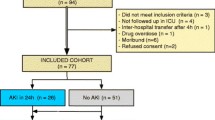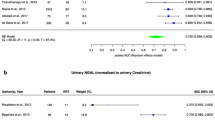Abstract
Acute kidney injury (AKI) represents a common disorder in hospitalized patients, and its incidence is rising at an alarming rate. Despite significant improvements in critical care and renal replacement therapies (RRT), the outcome of critically ill patients with AKI necessitating RRT remains unacceptably dismal. In current clinical practice, the diagnosis and severity classification of AKI is based on a rise in serum creatinine levels, which may occur 2–3 days after the initiating renal insult and delay potentially effective therapies that are limited to the early stage.
The emergence of numerous renal tubular damage-specific biomarkers offers an opportunity to diagnose AKI at an early timepoint, to facilitate differential diagnosis of structural and functional AKI, and to predict the outcome of established AKI. The purposes of this review are to summarize and to discuss the performance of these novel AKI biomarkers in various clinical settings.
The most promising AKI biomarkers include plasma and urinary neutrophil gelatinase-associated lipocalin (NGAL), urinary interleukin (IL)-18, urinary liver-type fatty acid binding protein (L-FABP), urinary cystatin C, and urinary kidney injury molecule (KIM)-1. However, enthusiasm about their usefulness in the emergency department seems unwarranted at present. There is little doubt that urinary biomarkers of nephron damage may enable prospective diagnostic and prognostic stratification in the emergency department. However, comparison of the areas under the receiver-operating characteristic curves of these biomarkers with clinical and/or routine biochemical outcome parameters reveals that none of these biomarkers has a clear advantage beyond the traditional approach in clinical decision making in patients with AKI. The performance of various biomarkers for predicting AKI in patients with sepsis or with acute-on-chronic kidney disease is poor. The inability of biomarkers to improve classification of ‘unclassifiable’ (structural or functional) AKI, in which accurate differential diagnosis of pre-renal versus intrinsic renal AKI has the most value, illustrates another problem. Future research is necessary to clarify whether serial measurements of a specific biomarker or the use of a panel of biomarkers may be more useful in critically ill patients at risk of AKI.
Whether or not the use of AKI biomarkers revolutionizes critical care medicine by early diagnosis of severe AKI and individualizes the management of AKI patients remains to be shown. Currently, the place of biomarkers in this decision-making process is still uncertain. Indiscriminate use of various biomarkers may distract clinicians from adequate clinical evaluation, may result in worse instead of better patient outcomes, and may waste money. Future large randomized studies are necessary to demonstrate the association between biomarker levels and clinical outcomes, such as dialysis, clinical events, or death. It needs to be shown whether assignment to earlier treatment for AKI on the basis of generally accepted biomarker cut-off levels results in a reduction in mortality and an improvement in recovery of renal function.

Similar content being viewed by others
References
Star RA. Treatment of acute renal failure. Kidney Int 1998; 54 (6): 1817–31.
Dennen P, Douglas IS, Anderson R. Acute kidney injury in the intensive care unit: an update and primer for the intensivist. Crit Care Med 2010; 38 (1): 261–75.
Amin AP, Salisbury AC, McCullough PA, et al. Trends in the incidence of acute kidney injury in patients hospitalized with acute myocardial infarction. Arch Intern Med 2012; 172 (3): 246–53.
Ostermann M, Chang RW. Challenges of defining acute kidney injury. QJM 2011; 104 (3): 237–43.
Hoste EA, Clermont G, Kersten A, et al. RIFLE criteria for acute kidney injury are associated with hospital mortality in critically ill patients: a cohort analysis. Crit Care 2006; 10 (3): R73.
Bellomo R, Ronco C, Kellum JA, et al. Acute renal failure — definition, outcome measures, animal models, fluid therapy and information technology needs: the Second International Consensus Conference of the Acute Dialysis Quality Initiative (ADQI) Group. Crit Care 2004 Aug; 8 (4): R204–12.
Piccinni P, Cruz DN, Gramaticopolo S, et al. Prospective multicenter study on epidemiology of acute kidney injury in the ICU: a critical care nephrology Italian collaborative effort (NEFROINT). Minerva Anestesiol 2011; 77 (11): 1072–83.
Schiffl H. Renal recovery from acute tubular necrosis requiring renal replacement therapy: a prospective study in critically ill patients. Nephrol Dial Transplant 2006; 21 (5): 1248–52.
Morrow DA, de Lemos JA. Benchmarks for the assessment of novel cardiovascular biomarkers. Circulation 2007; 115 (8): 949–52.
Nguyen M, Devarajan P. Biomarkers for the early detection of acute kidney injury. Pediatr Nephrol 2008; 23 (12): 2151–7.
Lisowska-Myjak B. Serum and urinary biomarkers of acute kidney injury. Blood Purif 2010; 29 (4): 357–65.
Mishra J, Dent C, Tarabishi R, et al. Neutrophil gelatinase-associated lipocalin (NGAL) as a biomarker for acute renal injury after cardiac surgery. Lancet 2005; 365 (9466): 1231–8.
Haase-Fielitz A, Bellomo R, Devarajan P, et al. Novel and conventional serum biomarkers predicting acute kidney injury in adult cardiac surgery — a prospective cohort study. Crit Care Med 2009; 37 (2): 553–60.
Wagener G, Jan M, Kim M, et al. Association between increases in urinary neutrophil gelatinase-associated lipocalin and acute renal dysfunction after adult cardiac surgery. Anesthesiology 2006; 105 (3): 485–91.
Koyner JL, Bennett MR, Worcester EM, et al. Urinary cystatin C as an early biomarker of acute kidney injury following adult cardiothoracic surgery. Kidney Int 2008; 74 (8): 1059–69.
Parikh CR, Mishra J, Thiessen-Philbrook H, et al. Urinary IL-18 is an early predictive biomarker of acute kidney injury after cardiac surgery. Kidney Int 2006; 70 (1): 199–203.
Yavuz I, Asgun FH, Bolcal C, et al. Importance of urinary measurement of glutathione S-transferase in renal dysfunction patients after on- and off-pump coronary artery bypass surgery. Thorac Cardiovasc Surg 2009; 57 (3): 125–9.
Matsui K, Kamijo-Ikemori A, Sugaya T, et al. Usefulness of urinary biomarkers in early detection of acute kidney injury after cardiac surgery in adults. Circ J 2012; 76 (1): 213–20.
McIlroy DR, Wagener G, Lee HT. Neutrophil gelatinase-associated lipocalin and acute kidney injury after cardiac surgery: the effect of baseline renal function on diagnostic performance. Clin J Am Soc Nephrol 2010; 5 (2): 211–9.
Haase M, Bellomo R, Devarajan P, et al. Accuracy of neutrophil gelatinase-associated lipocalin (NGAL) in diagnosis and prognosis in acute kidney injury: a systematic review and meta-analysis. Am J Kidney Dis 2009; 54 (6): 1012–24.
Lameire NH, Vanholder RC, Van Biesen WA. How to use biomarkers efficiently in acute kidney injury. Kidney Int 2011; 79 (10): 1047–50.
Siew ED, Ware LB, Gebretsadik T, et al. Urine neutrophil gelatinase-associated lipocalin moderately predicts acute kidney injury in critically ill adults. J Am Soc Nephrol 2009; 20 (8): 1823–32.
Siew ED, Ikizler TA, Gebretsadik T, et al. Elevated urinary IL-18 levels at the time of ICU admission predict adverse clinical outcomes. Clin J Am Soc Nephrol 2010; 5 (8): 1497–505.
Endre ZH, Pickering JW, Walker RJ, et al. Improved performance of urinary biomarkers of acute kidney injury in the critically ill by stratification for injury duration and baseline renal function. Kidney Int 2011; 79 (10): 1119–30.
Parikh CR, Devarajan P, Zappitelli M, et al. Postoperative biomarkers predict acute kidney injury and poor outcomes after pediatric cardiac surgery. J Am Soc Nephrol 2011; 22 (9): 1737–47.
Dent CL, Ma Q, Dastrala S, et al. Plasma neutrophil gelatinase-associated lipocalin predicts acute kidney injury, morbidity and mortality after pediatric cardiac surgery: a prospective uncontrolled cohort study. Crit Care 2007; 11 (6): R127.
Bennett M, Dent CL, Ma Q, et al. Urine NGAL predicts severity of acute kidney injury after cardiac surgery: a prospective study. Clin J Am Soc Nephrol 2008; 3 (3): 665–73.
Perianayagam MC, Seabra VF, Tighiouart H, et al. Serum cystatin C for prediction of dialysis requirement or death in acute kidney injury: a comparative study. Am J Kidney Dis 2009; 54 (6): 1025–33.
Liangos O, Perianayagam MC, Vaidya VS, et al. Urinary N-acetyl-beta-(D)-glucosaminidase activity and kidney injury molecule-1 level are associated with adverse outcomes in acute renal failure. J Am Soc Nephrol 2007; 18 (3): 904–12.
de Geus HR, Bakker J, Lesaffre EM, et al. Neutrophil gelatinase-associated lipocalin at ICU admission predicts for acute kidney injury in adult patients. Am J Respir Crit Care Med 2011; 183 (7): 907–14.
Nejat M, Hill JV, Pickering JW, et al. Albuminuria increases cystatin C excretion: implications for urinary biomarkers. Nephrol Dial Transplant. Epub 2011 May 5.
Doi K, Negishi K, Ishizu T, et al. Evaluation of new acute kidney injury biomarkers in a mixed intensive care unit. Crit Care Med 2011; 39 (11): 2464–9.
Nickolas TL, Schmidt-Ott KM, Canetta P, et al. Diagnostic and prognostic stratification in the emergency department using urinary biomarkers of nephron damage: a multicenter prospective cohort study. J Am Coll Cardiol 2012; 59 (3): 246–55.
Nejat M, Pickering JW, Devarajan P, et al. Some biomarkers of acute kidney injury are increased in pre-renal acute injury. Kidney Int. Epub 2012 Mar 14.
Singer E, Elger A, Elitok S, et al. Urinary neutrophil gelatinase-associated lipocalin distinguishes pre-renal from intrinsic renal failure and predicts outcomes. Kidney Int 2011; 80 (4): 405–14.
Hall IE, Coca SG, Perazella MA, et al. Risk of poor outcomes with novel and traditional biomarkers at clinical AKI diagnosis. Clin J Am Soc Nephrol 2011; 6 (12): 2740–9.
Haase M, Devarajan P, Haase-Fielitz A, et al. The outcome of neutrophil gelatinase-associated lipocalin-positive subclinical acute kidney injury: a multicenter pooled analysis of prospective studies. J Am Coll Cardiol 2011; 57 (17): 1752–61.
Koyner JL, Garg AX, Coca SG, et al. Biomarkers predict progression of acute kidney injury after cardiac surgery. J Am Soc Nephrol 2012; 23 (5): 905–14.
Waikar SS, Betensky RA, Emerson SC, et al. Imperfect gold standards for kidney injury biomarker evaluation. J Am Soc Nephrol 2012; 23 (1): 13–21.
Ralib AM, Pickering JW, Shaw GM, et al. Test characteristics of urinary biomarkers depend on quantitation method in acute kidney injury. J Am Soc Nephrol 2012; 23 (2): 322–33.
Tonomura Y, Uehara T, Yamamoto E, et al. Decrease in urinary creatinine in acute kidney injury influences diagnostic value of urinary biomarker-to-creatinine ratio in rats. Toxicology 2011; 290 (2–3): 241–8.
Haase M, Haase-Fielitz A. Acute kidney injury after cardiac surgery: early diagnosis with neutrophil gelatinase-associated lipocalin. Med Klin (Munich) 2011; 106 (2): 111–6.
Devarajan P. Neutrophil gelatinase-associated lipocalin: a promising biomarker for human acute kidney injury. Biomark Med 2010; 4 (2): 265–80.
Cullen MR, Murray PT, Fitzgibbon MC. Establishment of a reference interval for urinary neutrophil gelatinase-associated lipocalin. Ann Clin Biochem 2012; 49 (Pt 2): 190–3.
Cruz DN, de Geus HR, Bagshaw SM. Biomarker strategies to predict need for renal replacement therapy in acute kidney injury. Semin Dial 2011; 24 (2): 124–31.
Krawczeski CD, Goldstein SL, Woo JG, et al. Temporal relationship and predictive value of urinary acute kidney injury biomarkers after pediatric cardiopulmonary bypass. J Am Coll Cardiol 2011; 58 (22): 2301–9.
Han WK, Wagener G, Zhu Y, et al. Urinary biomarkers in the early detection of acute kidney injury after cardiac surgery. Clin J Am Soc Nephrol 2009; 4 (5): 873–82.
Shapiro NI, Trzeciak S, Hollander JE, et al. The diagnostic accuracy of plasma neutrophil gelatinase-associated lipocalin in the prediction of acute kidney injury in emergency department patients with suspected sepsis. Ann Emerg Med 2010; 56 (1): 52–9.
Devarajan P. Emerging biomarkers for the early detection of acute kidney injury. US Nephrology 2010; 5 (2): 38–44.
Westenfelder C. Earlier diagnosis of acute kidney injury awaits effective therapy. Kidney Int 2011; 79 (11): 1159–61.
Acknowledgments
No sources of funding were used to prepare this article. The authors have no conflicts of interest that are directly relevant to the content of this article.
Author information
Authors and Affiliations
Corresponding author
Rights and permissions
About this article
Cite this article
Schiffl, H., Lang, S.M. Update on Biomarkers of Acute Kidney Injury. Mol Diagn Ther 16, 199–207 (2012). https://doi.org/10.1007/BF03262209
Published:
Issue Date:
DOI: https://doi.org/10.1007/BF03262209




